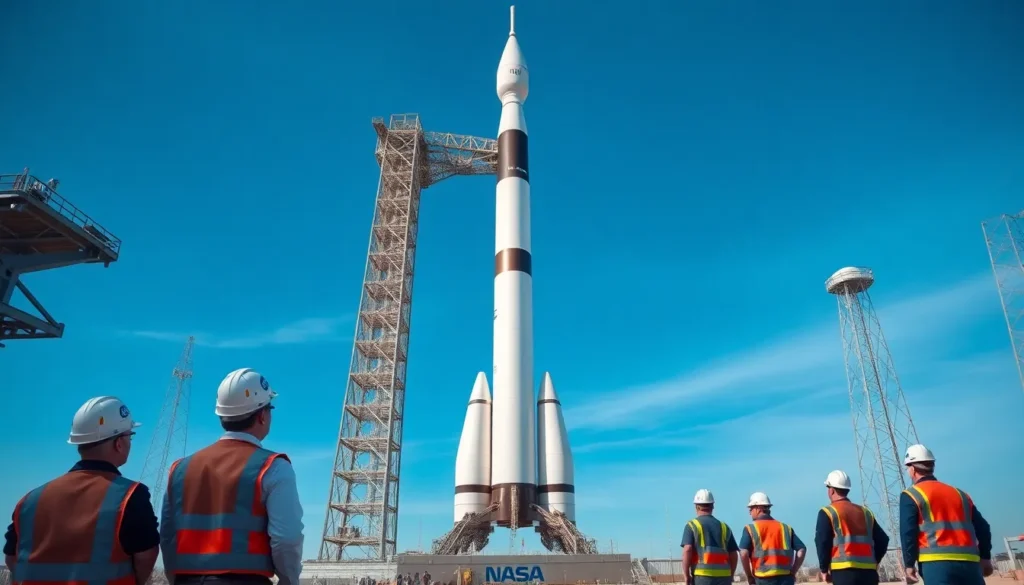When it comes to rocket launches, excitement is just part of the equation. Picture this: a massive rocket, standing tall like a skyscraper, ready to defy gravity and take humanity to the stars. It’s not just a spectacle; it’s a testament to human ingenuity and a reminder that sometimes, the sky isn’t the limit—it’s just the beginning.
As the countdown ticks away, anticipation builds. Will it soar smoothly into orbit or create a dramatic scene worthy of a Hollywood blockbuster? The thrill of a rocket launch captivates audiences around the globe, blending science, technology, and a sprinkle of good old-fashioned drama. Strap in and get ready to explore the fascinating world of rocket launches, where every liftoff is a leap into the unknown and a giant step for mankind.
Table of Contents
ToggleOverview of Rocket Launches
Rocket launches represent the culmination of extensive planning and engineering. These events involve multiple phases, from pre-launch preparations to actual lift-off. Launch sites often include specific locations such as Cape Canaveral, Kennedy Space Center, and Baikonur Cosmodrome, each offering unique advantages for specific missions.
Preparation activities encompass rugged testing of rocket systems. Engineers conduct simulations and assess components to ensure reliability. Many launches are part of larger missions, such as satellite deployments, interplanetary voyages, or supply runs to the International Space Station.
The excitement becomes palpable as the countdown begins. Families, engineers, and space enthusiasts gather to witness the moment, often livestreamed for global audiences. Sound waves from the powerful engines create a thrilling atmosphere, often experienced before the rocket even lifts off.
Launches also serve as significant milestones for space agencies and private companies like NASA and SpaceX. The success rate varies, with leading organizations prioritizing advancements through rigorous testing. Key factors affecting launch performance include weather conditions, technical readiness, and operational protocols.
Post-launch evaluations follow each mission, providing critical data for future endeavors. This data helps refine techniques and technology, ensuring the continued evolution of space exploration. As humanity embarks on more ambitious projects, from Artemis missions to Mars colonization, each rocket launch shapes the future of exploration and technology.
Historical Milestones in Rocket Launches

Rocket launches mark pivotal moments in space exploration, showcasing human achievement and advancing technology.
Early Space Exploration
The journey began with the launch of V-2 rockets by Germany in 1944, laying the groundwork for modern rocketry. In 1957, the Soviet Union launched Sputnik 1, marking the first artificial satellite in orbit. This event ignited the Space Age and triggered the space race between the United States and the Soviet Union. The launch of Explorer 1 by the U.S. in 1958 soon followed, furthering scientific understanding of the Earth’s radiation belts.
Notable Launches in History
Several notable launches helped shape the future of space exploration. Apollo 11’s historic ascent in 1969 allowed humans to land on the Moon for the first time. The Space Shuttle program, beginning in 1981, revolutionized human spaceflight by enabling reusable spacecraft. In 2004, SpaceShipOne became the first privately funded spacecraft to reach space, showcasing advancements in commercial space travel. More recently, SpaceX’s Falcon 9 rocket achieved a significant milestone in 2010 by successfully launching and landing reusable stages, marking a new era in rocket technology.
Types of Rocket Launches
Rocket launches can be categorized primarily into two types: orbital launches and suborbital launches. Each type serves distinct purposes and has unique characteristics.
Orbital Launches
Orbital launches place payloads into specific Earth orbits. They require rockets to reach velocities of around 17,500 miles per hour to achieve this. Many satellites, including communication and weather satellites, enter into geostationary or low Earth orbits through these launches. Launch sites such as Cape Canaveral in Florida are often utilized for their extensive capabilities and infrastructure. Successful orbital launches enable ongoing operations in space, supporting technologies that millions of people use daily. SpaceX’s Falcon 9 rocket exemplifies modern capabilities for these missions, demonstrating reliability and cost-effectiveness in deploying numerous satellites at once.
Suborbital Launches
Suborbital launches, on the other hand, send payloads into space but do not achieve orbital velocity. Launches typically reach altitudes of about 62 miles, crossing the Kármán line, which defines the boundary of space. Scientific experiments and technology demonstrations frequently utilize these launches. Companies like Blue Origin focus on suborbital tourism, allowing passengers to experience microgravity briefly. Often, schools and universities conduct experiments on these flights, gaining valuable data for educational purposes. The cost and complexity of suborbital launches allow for more frequent opportunities to reach space compared to orbital launches.
The Rocket Launch Process
The rocket launch process involves meticulous planning and coordination. Each phase guarantees safety and success, culminating in a spectacular liftoff.
Pre-Launch Preparations
Extensive preparations precede any rocket launch. Engineers conduct rigorous testing, including static fire tests and simulations of various scenario outcomes. Assessments of systems and components confirm readiness for the challenging mission ahead. Final checks typically occur days before the launch, ensuring all elements function correctly. Teams at launch sites, such as Cape Canaveral, work around the clock to prepare the vehicle and mission payloads. Collaboration among engineers, scientists, and mission planners is crucial, focusing on detailed timelines, safety protocols, and launch parameters.
Launch Sequence
A precise launch sequence dictates the entire timeline of events on launch day. Countdown procedures begin hours before liftoff, ensuring that each task is executed in perfect order. Engines ignite shortly before launch, generating immense thrust on a predetermined schedule. T-minus counts guide teams through critical moments, such as fueling and system checks, while the rocket stands ready. As the clock hits zero, powerful engines roar to life, propelling the rocket skyward. Each second counts during this phase, with split-second decisions affecting the mission’s success.
The Future of Rocket Launch Technology
Advancements in rocket launch technology focus on making missions more efficient and affordable. Companies like SpaceX push the boundaries with reusable rocket designs, significantly reducing costs for satellite launches. Reusability enhances sustainability by minimizing waste, allowing rockets to be refurbished and launched multiple times.
Innovative propulsion systems are on the horizon. Electric propulsion, for instance, offers higher efficiency and lower fuel consumption than traditional chemical rockets. This technology could transform deep space missions, enabling exploration of distant planets and asteroids.
Small satellite launches present an emerging trend. Dedicated small launch vehicles cater specifically to the growing demand for satellite deployment. With smaller, more flexible options like Rocket Lab’s Electron, companies can access space more frequently and at lower costs.
International collaboration drives progress in rocket launch technology. Space agencies around the world share knowledge and resources to address common challenges. Projects such as the Lunar Gateway, which involves collaboration between NASA, ESA, and other partners, highlight the potential of united efforts.
Automated systems are becoming standard in launch operations. Automation reduces human error, increases precision, and enables more rapid response to changing conditions. Advanced algorithms analyze data for real-time decision-making during launch.
A focus on green technologies is also evident. Liquid oxygen and biofuels serve as alternatives to traditional rocket fuels, reducing environmental impact. Innovations in green propulsion align with global goals for sustainability in space activities.
Central to future developments is the rise of commercial spaceflight. The growing market for space tourism showcases humanity’s expanding access to space. Companies like Blue Origin and Virgin Galactic are leading this charge, bringing the dream of space travel closer to reality.
Next waves of innovation promise to reshape the landscape of rocket launches, driving exploration and igniting further interest in the cosmos. Each leap forward in technology creates new opportunities for discovery, adventure, and scientific advancement.
Rocket launches embody the pinnacle of human achievement and technological prowess. Each event not only marks a significant milestone in space exploration but also fuels the collective imagination of people around the globe. As advancements continue to reshape the landscape of space travel, the excitement surrounding these launches only grows.
The future promises even more thrilling developments with reusable technology and international collaboration paving the way for ambitious missions. Whether it’s deploying satellites or embarking on interplanetary journeys, every launch contributes to humanity’s quest for knowledge and discovery. The journey into the cosmos is just beginning, and each rocket launch represents a step closer to unlocking the mysteries of the universe.








